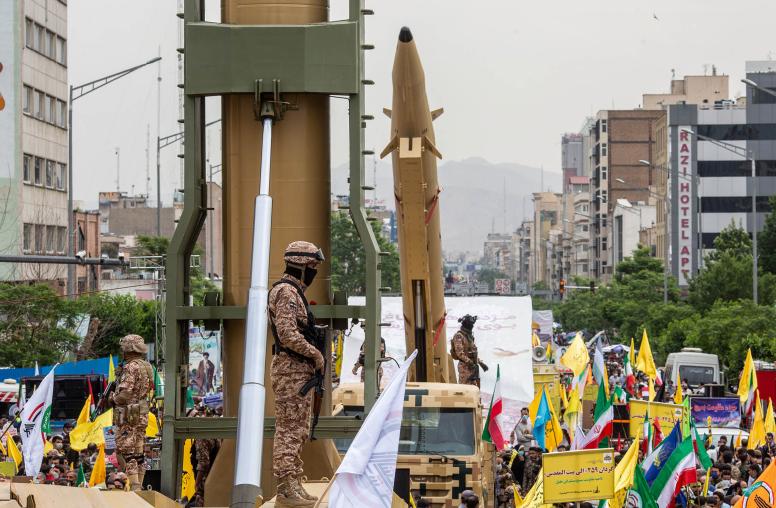Iran-U.S. Window of Opportunity Fraught With Danger
It is too early to say whether President Hassan Rouhani’s September 24 speech before the United Nations General Assembly will elicit the diplomatic opening that Iran’s leaders seem to be hoping for. But a window of opportunity has opened for a renewed international effort to address the fears and concerns generated by Iran’s nuclear program.

That brings both sides into an unprecedented zone of both opportunity and danger: opportunity because the diplomatic stars may briefly align in ways that favor a sustained and, most of all, substantive dynamic of international negotiations on the nuclear issue; danger because, as expectations of possible progress rise, so do the potential consequences of failure. If things fall apart, U.S. leaders may decide that the time to move from diplomacy to force has finally arrived. The stakes are huge.
The dominant narrative among Iran watchers in Washington is that Rouhani’s campaign is largely a consequence of the punishing impact of international sanctions. Among other effects, these sanctions have made it difficult for Iran to sell oil, the lifeline of the regime. Rouhani is certainly under a great deal of pressure from those who voted for him to persuade the international community and the U.S. in particular to lift some of these sanctions.
But it would be a mistake to attribute Rouhani’s efforts solely to such economic or social concerns. The bigger challenge facing him is how to translate his unexpected electoral victory into a longer-term strategy for opening up the Iranian political system.
While such an opening might be small and may even fall quite short of what many Iranian democratic activists within and especially outside Iran hope for, it could nevertheless be significant. A political entente between social forces from the opposition and the regime, mediated by a political leader who has the trust of many clerics and –perhaps most importantly – the support (for now) of Supreme Leader Khamenei, could provide the necessary consensus for a further relaxation of the political arena. With parliamentary elections on the horizon in 2016, the reformists sense an opportunity to reenter the political fray.
That opportunity will hinge, in no small part, on the evolution of Iran’s regional and global relationships. Rouhani knows that political détente at home will depend in small measure of diplomatic détente abroad. His potential adversaries in the hard-line camp know this as well. From the very inception of Iran’s reformist movement in the late nineties under former President Mohammed Khatami, Iran’s reformists have looked to engagement in the international arena as a mechanism for increasing leverage at home. Khatami’s notion of a “dialogue of civilizations” was not merely about opening Iran’s relations with the West, but also about promoting a dialogue within Iran’s own multi-faceted and highly pluralistic “civilization.” It was for this reason that hard liners worked to undermine reformists on the domestic front and to sabotage any pursuit of more cordial relations with the West.
It is in this light, I believe, that we can understand the plethora of warnings and implicit threats that hardliners directed at Rouhani both before and after his U.N. speech. They sense a slippery slope that could carry Iran much further than even Rouhani might imagine.
But there is one critical difference between Rouhani’s situation and that of former President Khatami: the support of the Supreme Leader for the current president’s effort. Having called for “heroic flexibility” before an audience of the Revolutionary Guard on September 17, Khamenei suggested his support, not only for a more robust initiative on the nuclear front, but possibly as well for a somewhat more open approach domestically. The release of some 80 political prisoners--most of whom were arrested after the notorious clamp down on the opposition that followed the June 2009 presidential elections—suggests that the Leader may now be prepared to countenance some kind of domestic negotiation and reconciliation—even if limited and, at the outset, very modest.
Rouhani’s challenge is to make quick progress on the nuclear negotiations without antagonizing those forces who are aligned against him, or without raising fears that might reverse the support of the Supreme Leader.
This will be an extremely tricky line to walk, as Rouhani’s own speech before the U.N. General Assembly showed. He declared that “peace is within reach,” that Iran had no desire to pursue nuclear weapons, and that the country would enter into negotiations designed to address all “reasonable concerns.” But he also condemned unnamed “warmongers” for agitating for an attack on Iran, dismissed any effort to intimidate his country into making concessions, and insisted that Iran would not give up it “rights” to produce peaceful nuclear power – a code word for maintaining enrichment at home.
President Barack Obama, for his part, signaled in his U.N. speech that addressing the controversy over Iran’s nuclear program remains one of the two key Middle East foreign policy challenges of his administration, the other being the Israeli-Palestinian peace process. On Iran, Obama alluded to signs that Rouhani’s efforts are driven by the expectations of the Iranian people and the election results. "We are encouraged that President Rouhani received from the Iranian people a mandate to pursue a more moderate course," the president said.
Given the fears and concerns that have been sparked in many quarters by the efforts to reenergize the negotiating track, U.S. and Iranian leaders will have to demonstrate exceptional skill and political will as they struggle to find an exit from decades of distrust and conflict.
Daniel Brumberg is a senior program officer at USIP, focusing on democratization and political reform in the Middle East and the wider Islamic world.



